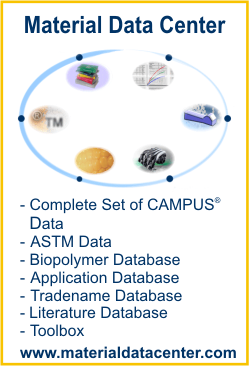Material Data Center is a leading international information system for the plastics industry. Material Data Center offers a comprehensive plastics database, calculation tools, CAE interfaces, a literature database and an application database. For more information about Material Data Center visit www.materialdatacenter.com.
This is the free Material Data Center Datasheet of Ultramid® B3ZG7 OSI BK23273 - PA6-GF35 - BASF
unit conversion, PDF datasheet print, comparison with other plastics, snap fit calculation, beam deflection calculation, CAE Interfaces
Check here, which other Ultramid B datasheets, application examples or technical articles are available in Material Data Center
| 加工/物理特性 | 干 / 已调节 | 单位 | Test Standard | ||||||||||||||||||||||||||||||||||||||||||||||||||||||||||||||||||||||||||||||||||||||||||||||||
| ISO数据 | |||||||||||||||||||||||||||||||||||||||||||||||||||||||||||||||||||||||||||||||||||||||||||||||||||
| 模塑收缩率, 平行 | 0.2 / * | % | ISO 294-4, 2577 | ||||||||||||||||||||||||||||||||||||||||||||||||||||||||||||||||||||||||||||||||||||||||||||||||
| 模塑收缩率, 垂直 | 0.6 / * | % | ISO 294-4, 2577 | ||||||||||||||||||||||||||||||||||||||||||||||||||||||||||||||||||||||||||||||||||||||||||||||||
| 机械性能 | 干 / 已调节 | 单位 | Test Standard | ||||||||||||||||||||||||||||||||||||||||||||||||||||||||||||||||||||||||||||||||||||||||||||||||
| ISO数据 | |||||||||||||||||||||||||||||||||||||||||||||||||||||||||||||||||||||||||||||||||||||||||||||||||||
| 拉伸模量 | 10000 / 6170 | MPa | ISO 527 | ||||||||||||||||||||||||||||||||||||||||||||||||||||||||||||||||||||||||||||||||||||||||||||||||
| 断裂应力 | 170 / 112 | MPa | ISO 527 | ||||||||||||||||||||||||||||||||||||||||||||||||||||||||||||||||||||||||||||||||||||||||||||||||
| 断裂伸长率 | 3.5 / 11 | % | ISO 527 | ||||||||||||||||||||||||||||||||||||||||||||||||||||||||||||||||||||||||||||||||||||||||||||||||
| 弯曲模量, 23°C | 8920 / 5650 | MPa | ISO 178 | ||||||||||||||||||||||||||||||||||||||||||||||||||||||||||||||||||||||||||||||||||||||||||||||||
| 无缺口简支梁冲击强度, +23°C | 102 / 106 | kJ/m² | ISO 179/1eU | ||||||||||||||||||||||||||||||||||||||||||||||||||||||||||||||||||||||||||||||||||||||||||||||||
| 简支梁冲击强度, -30°C | 113 / - | kJ/m² | ISO 179/1eU | ||||||||||||||||||||||||||||||||||||||||||||||||||||||||||||||||||||||||||||||||||||||||||||||||
| 简支梁缺口冲击强度, +23°C | 26 / 34 | kJ/m² | ISO 179/1eA | ||||||||||||||||||||||||||||||||||||||||||||||||||||||||||||||||||||||||||||||||||||||||||||||||
| 简支梁缺口冲击强度, -30°C | 18 / - | kJ/m² | ISO 179/1eA | ||||||||||||||||||||||||||||||||||||||||||||||||||||||||||||||||||||||||||||||||||||||||||||||||
| 悬臂梁缺口冲击强度, +23°C | 24 / 34 | kJ/m² | ISO 180/1A | ||||||||||||||||||||||||||||||||||||||||||||||||||||||||||||||||||||||||||||||||||||||||||||||||
| 悬臂梁缺口冲击强度 | 17 / - | kJ/m² | ISO 180/1A | ||||||||||||||||||||||||||||||||||||||||||||||||||||||||||||||||||||||||||||||||||||||||||||||||
| 悬臂梁缺口冲击强度 - 温度 | -40 | °C | - | ||||||||||||||||||||||||||||||||||||||||||||||||||||||||||||||||||||||||||||||||||||||||||||||||
| 热性能 | 干 / 已调节 | 单位 | Test Standard | ||||||||||||||||||||||||||||||||||||||||||||||||||||||||||||||||||||||||||||||||||||||||||||||||
| ISO数据 | |||||||||||||||||||||||||||||||||||||||||||||||||||||||||||||||||||||||||||||||||||||||||||||||||||
| 熔融温度, 10°C/min | 220 / * | °C | ISO 11357-1/-3 | ||||||||||||||||||||||||||||||||||||||||||||||||||||||||||||||||||||||||||||||||||||||||||||||||
| 热变形温度, 1.80 MPa | 206 / * | °C | ISO 75-1/-2 | ||||||||||||||||||||||||||||||||||||||||||||||||||||||||||||||||||||||||||||||||||||||||||||||||
| 热变形温度, 0.45 MPa | 220 / * | °C | ISO 75-1/-2 | ||||||||||||||||||||||||||||||||||||||||||||||||||||||||||||||||||||||||||||||||||||||||||||||||
| 线性热膨胀系数, 平行 | 13.1 / * | E-6/K | ISO 11359-1/-2 | ||||||||||||||||||||||||||||||||||||||||||||||||||||||||||||||||||||||||||||||||||||||||||||||||
| 线性热膨胀系数, 垂直 | 110 / * | E-6/K | ISO 11359-1/-2 | ||||||||||||||||||||||||||||||||||||||||||||||||||||||||||||||||||||||||||||||||||||||||||||||||
| 其它性能 | 干 / 已调节 | 单位 | Test Standard |
| 吸湿性 | 1.7 / * | % | 类似ISO 62 |
| 密度 | 1380 / - | kg/m³ | ISO 1183 |
| 加工推荐(注塑) | 价值 | 单位 | Test Standard |
| 预干燥-温度 | 80 | °C | - |
| 预干燥-时间 | 2 - 4 | h | - |
| 加工湿度 | ≤0.08 | % | - |
| 注塑熔体温度 | 270 - 295 | °C | - |
| 模具温度 | 80 - 95 | °C | - |
| 1区 | 245 - 275 | °C | - |
| 2区 | 260 - 285 | °C | - |
| 3区 | 270 - 295 | °C | - |
| 喷嘴温度 | 270 - 295 | °C | - |
| 注射压力 | 3.5 - 12.5 | MPa | - |
Pre/Post-processing, max. allowed water content: .08 %
Pre/Post-processing, Pre-drying, Temperature: 80 °C
Pre/Post-processing, Pre-drying, Time: 2 - 4 h
PROCESSING
injection molding, Melt temperature, range: 270 - 295 °C
injection molding, Mold temperature, range: 80 - 95 °C
Material Handling
Max. Water content: 0.08%
Product is supplied in sealed containers and drying prior to molding is not required. If drying becomes necessary, a dehumidifying or desiccant dryer operating at 80 °C (176 °F) is recommended. Drying time is dependent on moisture level but 2-4 hours is generally sufficient.
Further information concerning safe handling procedures can be obtained from the Material Safety Data Sheet. Alternatively, please contact your BASF representative.
Typical Profile
Melt Temperature 270-295 °C (518-563 °F)
Mold Temperature 80-95 °C (176-203 °F)
Injection and Packing Pressure 35-125 bar (500-1800psi)
Rear Zone 245-275 °C (473-527 °F)
Center Zone 260-285 °C (500-545 °C)
Front Zone 270-295 °C (518-563 °F)
Nozzle 270-295 °C (518-563 °F)
Mold Temperatures
This product can be processed over a wide range of mold temperatures; however, for applications where aesthetics are critical, a mold surface temperature of 80-95 °C (176-203 °F) is required.
Pressures
Injection pressure controls the filling of the part and should be applied for 90% of ram travel. Packing pressure affects the final part and can be used effectively in controlling sink marks and shrinkage. It should be applied and maintained until the gate area is completely frozen off.
Back pressure can be utilized to provide uniform melt consistency and reduce trapped air and gas. Minimal back pressure should be utilized to prevent glass breakage. recommended to minimize glass fiber breakage.
Fill Rate
Fast fill rates are recommended to insure uniform melt delivery to the cavity and prevent premature freezing. Surface appearance is directly affected by injection rate.
Material Data Center is provided by M-Base Engineering + Software GmbH. M-Base Engineering + Software GmbH assumes no liability for the system to be free of errors. Any decision about the application of materials must be double checked with the producer of this material.
Additional information about this material, like producer contact address, etc. can be found at www.materialdatacenter.com. For access to this extra information a registration is requested. Free online registration is available.













